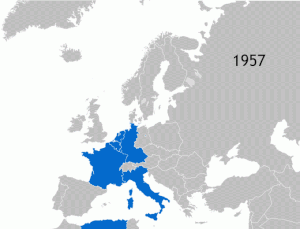Mary Elise Sarotte is a professor at the University of Southern California in their International Relations department. She focuses on Cold War history and especially the post-Cold War period, immediately following the destruction of the Berlin Wall. In her piece, In Victory, Magnanimity: US Foreign Policy, 1989-1991, and the Legacy of Prefabricated Multilateralism, Sarotte discusses the alternative structures that were proposed following the collapse of the Berlin Wall. She discusses four main possibilities, the second of which was proposed by Helmut Kohl, and deemed a revivalist vision. Kohl was the West German Chancellor and upon witnessing early American consent to Gorbachev’s attempted restoration of quadripartitism he created a different plan ((Sarotte, Mary. In Victory, Magnanimity: US Foreign Policy, 1989-1991, and the Legacy of Prefabricated Multilateralism. 2011.)) .
The revivalist vision was focused on recreating the ideas of German statehood, that is, recreating a confederation of German states. If it had been implemented, East and West Germany would have had independent social and political policies, however they would have been united under a single, national roof ((Sarotte, Mary. In Victory, Magnanimity: US Foreign Policy, 1989-1991, and the Legacy of Prefabricated Multilateralism. 2011.)). This architecture would have been successful in diffusing tension between East and West Germany, as they would be technically reunited under one German name, however, they would be allowed to have their own politics and remaining communist influence would have had the opportunity to be present in East German politics. It would have restored the self-governing capabilities to East Germany; however, it would not have created the strongest German state possible. By 1990, Kohl realized that his vision of a divided Germany under a united roof was not possible and switched towards advocating for American involvement in extending prefabricated institutions to Eastern countries.
Many of these possible architectures for restructuring took into account American involvement. Did American’s have the right to be so heavily involved in the restructuring of Europe or should they have been able to do it on their own? How would the outcomes have differed if Americans were not involved?


